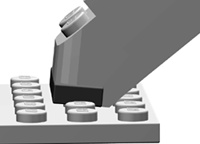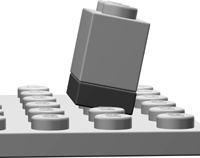Sooner or later you’re going to want to take one of your LEGO creations apart, whether it’s an official set that you built out of the box and put on a shelf for a few months, or a robot that you built last weekend. Eventually you’re going to want to reuse the pieces contained in it.
Although there’s nothing wrong with displaying your work, there is also a great deal to be gained by taking advantage of one of the other great qualities of the LEGO system—its reusability. Any piece can connect to almost any other piece. Working out all of these arrangements is part of what makes exploring and using the system so satisfying.
Now that you know it’s okay to take that model apart, what are you waiting for? Just start by pulling off large sections of bricks, breaking those down into smaller chunks, and finally separating individual bricks from one another. At some point, however, you are very likely to come across two or more pieces that are stuck together so tightly that you can’t pry them apart or even get a fingernail between them. Often these will be two small plates that are proving just how well the stud and tube mechanism works. Despite their best efforts to stay together, it is almost certain you’ll want to separate them. Let’s look at how best to do that.
In some official LEGO sets, and in some assorted tubs of bricks, you’ll find a rather odd looking piece of plastic (Figure 13-12). It isn’t quite a brick, but it does have some studs on it. It’s a brick separator.
If you haven’t got one of these little tools, you may want to consider buying one. Better yet, you may want to consider buying two since they work well in pairs. If you haven’t found one in a LEGO set, you can normally purchase them directly from the LEGO company’s Shop at Home service, http://shop.lego.com. Look for item #630.
Brick separators sell for a couple of dollars each. They will save you much more than that in dental fees by helping you separate bricks and plates without resorting to yanking them apart with your teeth.
Take, for example, two 2x2 plates stacked neatly together. They’ve been part of a model for months, and now they’re stuck together and won’t budge. Start by taking one of your brick separators in one hand; then place the 2x2 stacked plates studs down on top of it. Then bring the second separator down from above; this creates something that looks like the handles of a pair of pliers (see Figure 13-13). And, like the handles of a pair of pliers, you want to squeeze the two separators together. With very little effort and not much movement, you should find that the two plates begin to disconnect at the edge facing away from the brick separator tools. The forces you are applying—along the top surface of the upper plate and along the bottom surface of the lower plate—quickly create a gap at one edge of the two plates that generally allows the two pieces to separate from each other.
Figure 13-13. Two brick separators working to take apart two 2x2 plates. Gently squeezing the two handles is usually enough to quickly separate even the most stubborn pieces.
Perhaps your problem isn’t two small parts stuck together, but rather one small part firmly affixed to a larger one. Take the case of a 1x2 plate stuck in the middle of a 4x6 plate, as shown in Figure 13-14.
Figure 13-14. Sooner or later you’ll find yourself faced with the task of trying to remove a 1x2, like the one shown here, from the middle of a much larger piece.
A single brick separator can be of great use here; it can simply apply a bit of leverage so you can free the little piece. In Figure 13-15, I’ve included a close-up shot that shows the separator working its magic.
Figure 13-15. The brick separator’s unique design allows it to get close to the 1x2 plate and then lever it away from the larger plate beneath it.
Of course, it goes without saying that you can also use these separation techniques when you are constructing a new model for those times you put two pieces together and then quickly change your mind.
Also remember that not having a brick separator doesn’t mean stuck pieces have to remain like that forever. Take a look at Figure 13-16 for another example of how to separate such pieces. This time, I’m using two 1x2 plates. Because the plates are so small, it’s often hard to use your fingers to separate them. Instead of scratching away with your fingernails at the joint between them, try placing a 1x2 brick on the top and bottom of the plate combination.
Figure 13-16. 1x2 bricks on top and bottom of two 1x2 plates. This easy solution uses pieces you already have.
The bricks now give you enough leverage to cause a small separation between the plates. This is very similar to how the brick separator works; the gap that forms is usually enough to allow you to then separate the plates completely.
You can also use a brick instead of the separator in the other example I noted earlier—the one where you have a small plate stuck in the middle of a larger plate. To make this work, put the brick on top of the 1x2 plate (as demonstrated in Figure 13-17), and gently apply downward pressure as you tilt the brick toward the surface of the larger plate. If you do this without lifting up on the brick, you should find that the 1x2 plate loosens sufficiently from the studs of the 4x6 plate.






